Native Son: December 2014
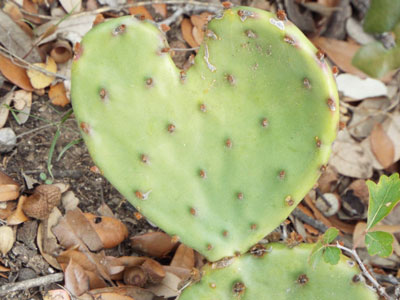
All photos by Steven Chamblee
by Steven Chamblee
There’s Treasure Everywhere
I heard it again today. Another well-meaning voice announcing loudly and proudly to out-of-town guests, “There was nothing here, nothing, until Douglas Chandor built his magnificent garden!” My lips smiled, but my spine stiffened in protest. It was not my tour, so I bit my lip and did not impart to them my opinion that this place is and never was “nothing.” It is a piece of Mother Earth that slowly formed over many millions of years, and the native flora and fauna that live here now have survived a 14,000-year (plus or minus) torture test of floods and freezes, droughts and dust that killed off every species that could not adapt to the environmental conditions. Well, maybe I am a little dramatic about the whole thing.
Even so, I decide to take a walk through the back forty. The air is cold, the wind is blowing, and my wandering mind soon conjures up an old Calvin and Hobbes comic strip where the 5-year-old boy finds an old soda bottle in a rubbish pile. Instead of seeing an old bottle, his childhood imagination takes over and he beholds the skull of an ancient dinosaur. Each subsequent piece of old trash is interpreted as a magnificent new discovery, until he proudly proclaims, “There’s treasure everywhere!” Calvin is my hero.
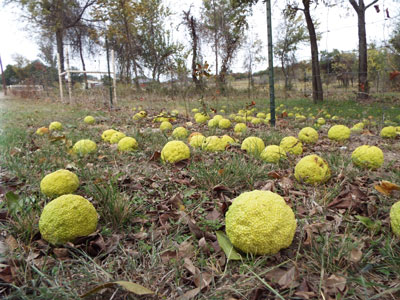
Dozens of horseapples cover the ground under a female bois d’arc tree.
I do indeed encounter treasure right away. A scattering of horseapples beneath a bois ‘d arc tree reminds me of my days at the Heard Museum in McKinney, and how I noticed nothing seemed to eat them — so I did some research and found out it is theorized that they were a food source for many of the large mammals that went extinct at the end of the recent Ice Age. And to think … I missed seeing mastodons and giant sloths by a mere blink of geologic time.
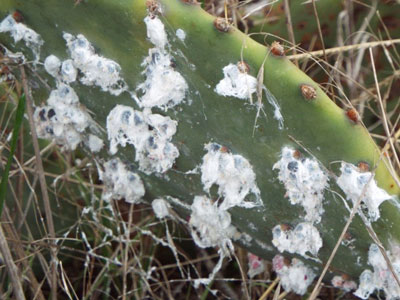
Fluffy white cochineal insects on a prickly pear pad turn bright purple when crushed on a napkin.
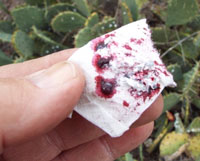 Prickly pear cacti quickly appear en masse, complete with cochineal insects upon their pads. My mind thinks about the guy who thought he would become a kazillionaire by producing the rich purple textile dye obtained from squishing these bugs. In 1788, he brought some cochineal-infested prickly pears to Australia on his ship and planted them. The insects promptly died, but the plants quickly took off and infested about 100,000 square miles, creating one of the most amazing cases of invasive species ever recorded. The cactus was finally eradicated by bringing in another insect, one that eats prickly pears. I laugh out loud at the thought that these days the squished bug dye is used … are you ready? … as food coloring and for creating those deep, rich-colored lipsticks! I wonder if Hollywood starlets know they are actually wearing bug juice on those million dollar lips….
Prickly pear cacti quickly appear en masse, complete with cochineal insects upon their pads. My mind thinks about the guy who thought he would become a kazillionaire by producing the rich purple textile dye obtained from squishing these bugs. In 1788, he brought some cochineal-infested prickly pears to Australia on his ship and planted them. The insects promptly died, but the plants quickly took off and infested about 100,000 square miles, creating one of the most amazing cases of invasive species ever recorded. The cactus was finally eradicated by bringing in another insect, one that eats prickly pears. I laugh out loud at the thought that these days the squished bug dye is used … are you ready? … as food coloring and for creating those deep, rich-colored lipsticks! I wonder if Hollywood starlets know they are actually wearing bug juice on those million dollar lips….
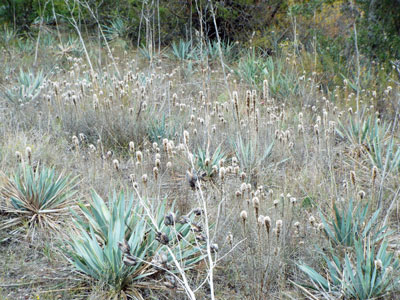
Hundreds of gayfeather stalks hold thousands of seeds. Ancient, fossilized shells give witness to an ancient sea.
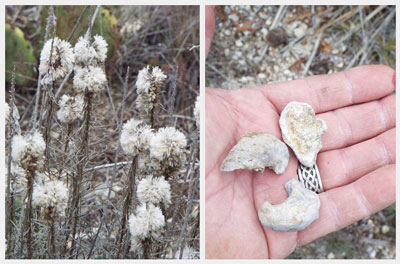
Faded gayfeather stalks still stand proudly over the rocky soil, each telling a story. Six weeks ago, the gayfeather flowers were providing nectar for the last of the Monarch butterflies headed south on their migration to Old Mexico. The seashell-laden rock below my feet was born a few years earlier, shortly after the extinction of the dinosaurs, when the Western Interior Seaway extended from north of Alaska to south of Mexico, enveloping all of the Lone Star State. Sadly, no photographs of this lovely sea, or the dinosaurs, exist today.
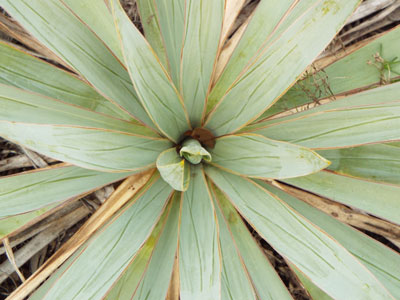
Pallid yuccas pretty much determine my path, as their spiny tips will go through denim with ease, but they are scattered fairly widely and don’t seem to form solid thickets too often. Many of them have “ghosting” upon their leaves, an irregular pattern impressed upon them while still packed tightly together in the bud. Common around here to the point that people often curse them, pallid yuccas are in great demand farther west; so much so that several commercial plant nurseries in Arizona regularly have me collect seed for them. Hmmm … Stevie Yuccaseed.
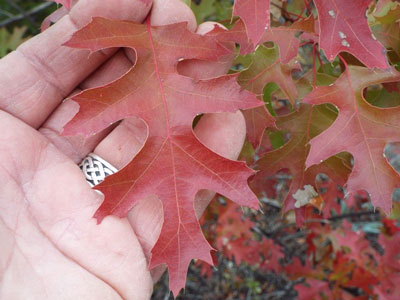
Texas red oak lives up to its name in autumn, and purple dalea still holds delicate blossoms after a hard freeze.
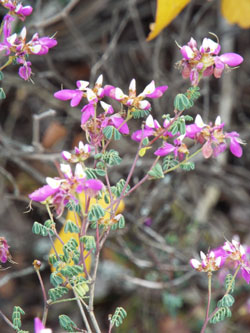 I cross through a narrow thicket of brightly colored Texas red oak trees between prairie pockets and get quite a surprise. Despite the recent hard freeze, several colonies of dalea are still covered with green leaves and those delicate purple flowers. Aside from being lovely, these blossoms provide excellent nectar for foraging insects, primarily bees. Bee problems and shortages have been publicized in the past few years, but we people probably won’t pay much attention until someone notices there aren’t any apples in the grocery store. Or peaches, pears, plums, cherries, okra, cashews, celery, beets, mustard, peppers, watermelons, papayas, hazelnuts, squash, lemons, limes, oranges, figs, strawberries, sunflowers, or blackberries. I can hear them now: “I can live without all that.” But I have an ace in the hole, my friend: NO BEES, NO COFFEE!!!
I cross through a narrow thicket of brightly colored Texas red oak trees between prairie pockets and get quite a surprise. Despite the recent hard freeze, several colonies of dalea are still covered with green leaves and those delicate purple flowers. Aside from being lovely, these blossoms provide excellent nectar for foraging insects, primarily bees. Bee problems and shortages have been publicized in the past few years, but we people probably won’t pay much attention until someone notices there aren’t any apples in the grocery store. Or peaches, pears, plums, cherries, okra, cashews, celery, beets, mustard, peppers, watermelons, papayas, hazelnuts, squash, lemons, limes, oranges, figs, strawberries, sunflowers, or blackberries. I can hear them now: “I can live without all that.” But I have an ace in the hole, my friend: NO BEES, NO COFFEE!!!
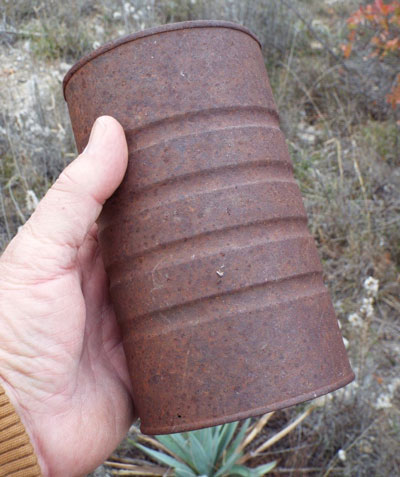
Discarded years ago in a prairie, the old rusty can finds new life as a container for Agave desmettiana ‘Variegata.’
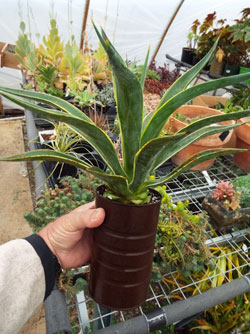 At the base of the dalea, I notice the first sign of people since I started this romp: an old, rusted tin can. Part of me thinks of it as litter that some stupid slob polluted the prairie with 50 years ago. But then Calvin comes out of nowhere and announces, “WOW! A Neanderthal left a really cool plant pot out here, and we are lucky enough to find it!” Who am I to argue? Calvin is my hero.
At the base of the dalea, I notice the first sign of people since I started this romp: an old, rusted tin can. Part of me thinks of it as litter that some stupid slob polluted the prairie with 50 years ago. But then Calvin comes out of nowhere and announces, “WOW! A Neanderthal left a really cool plant pot out here, and we are lucky enough to find it!” Who am I to argue? Calvin is my hero.
Come out and breathe in the beauty of Chandor Gardens! Go to www.chandorgardens.com for details. Just take I-20 west to exit 409, hang a right, go 2.1 miles and hang a left on Lee Avenue. Head straight 12 blocks and you’re driving in the gates. Call 817-361-1700 for more information.
I can always use another road trip! Let me know if you’d like me to come out and speak to your group sometime. I’m low-maintenance, flexible, and you know I like to go just about anywhere. No city too big; no town too small. Just send me an e-mail at stevenchamblee@yahoo.com and we’ll work something out.

